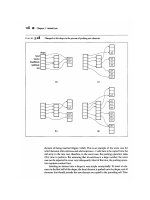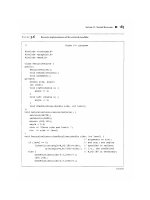core techniques and algorithms in game programming - daniel sanchez-crespo dalmau
Bạn đang xem bản rút gọn của tài liệu. Xem và tải ngay bản đầy đủ của tài liệu tại đây (10.99 MB, 745 trang )
This document was created by an unregistered ChmMagic, please go to to register it. Thanks
[ Team LiB ]
•
Table of Contents
•
Index
Core Techniques and Algorithms in Game Programming
By Daniel Sánchez-Crespo Dalmau
Publisher: New Riders Publishing
Pub Date: September 08, 2003
ISBN: 0-1310-2009-9
Pages: 888
To even try to keep pace with the rapid evolution of game development, you need a strong foundation in core programming
techniques-not a hefty volume on one narrow topic or one that devotes itself to API-specific implementations. Finally, there's a guide that
delivers! As a professor at the Spanish university that offered that country's first master's degree in video game creation, author Daniel
Sanchez-Crespo recognizes that there's a core programming curriculum every game designer should be well versed in-and he's outlined
it in these pages! By focusing on time-tested coding techniques-and providing code samples that use C++, and the OpenGL and DirectX
APIs-Daniel has produced a guide whose shelf life will extend long beyond the latest industry trend. Code design, data structures, design
patterns, AI, scripting engines, 3D pipelines, texture mapping, and more: They're all covered here-in clear, coherent fashion and with a
focus on the essentials that will have you referring back to this volume for years to come.
[ Team LiB ]
.
This document was created by an unregistered ChmMagic, please go to to register it. Thanks.
[ Team LiB ]
•
Table of Contents
•
Index
Core Techniques and Algorithms in Game Programming
By Daniel Sánchez-Crespo Dalmau
Publisher: New Riders Publishing
Pub Date: September 08, 2003
ISBN: 0-1310-2009-9
Pages: 888
Copyright
About the Author
About the Technical Reviewer
Acknowledgments
Tell Us What You Think
Introduction
What You Will Learn
What You Need to Know
How This Book Is Organized
Conventions
Chapter 1. A Chronology of Game Programming
Phase I: Before Spacewar
Phase II: Spacewar to Atari
Phase III: Game Consoles and Personal Computers
Phase IV: Shakedown and Consolidation
Phase V: The Advent of the Game Engine
Phase VI: The Handheld Revolution
Phase VII: The Cellular Phenomenon
Phase VIII: Multiplayer Games
In Closing
Chapter 2. Game Architecture
Real-Time Software
The Game Logic Section
The Presentation Section
The Programming Process
This document was created by an unregistered ChmMagic, please go to to register it. Thanks.
In Closing
Chapter 3. Data Structures and Algorithms
Types, Structures, and Classes
Data Structures
The Standard Template Library
In Closing
Chapter 4. Design Patterns
Design Patterns Defined
Some Useful Programming Patterns
Usability Patterns
In Closing
Chapter 5. User Input
The Keyboard
Mouse
Joysticks
Hardware Abstraction
Force Feedback
In Closing
Chapter 6. Fundamental AI Technologies
Context
Structure of an AI System
Specific Technologies
In Closing
Chapter 7. Action-Oriented AI
On Action Games
Choreographed AIs
Object Tracking
Chasing
Evasion
Patrolling
Hiding and Taking Cover
Shooting
Putting It All Together
In Closing
Chapter 8. Tactical AI
Tactical Thinking Explained
Military Analysis: Influence Maps
Representing Tactics
In Closing
Chapter 9. Scripting
Building a Scripting Language
Embedded Languages
Socket-Based Scripting
In Closing
Chapter 10. Network Programming
How the Internet Really Works
The Programmer's Perspective: Sockets
Clients
A Simple TCP Server
Multiclient Servers
This document was created by an unregistered ChmMagic, please go to to register it. Thanks.
UDP Servers
Preventing Socket Blocks
Designing Client-Server Games
Massively Multiplayer Games
In Closing
Chapter 11. 2D Game Programming
On Older Hardware
Data Structures for 2D Games
Mapping Matrices
2D Game Algorithms
Special Effects
In Closing
Chapter 12. 3D Pipeline Overview
A First Look
Fundamental Data Types
Geometry Formats
A Generic Graphics Pipeline
In Closing
Chapter 13. Indoors Rendering
General Analysis
Occluder-Based Algorithms
Binary Space Partition Algorithms
Portal Rendering
Hierarchical Occlusion Maps
Hybrid Approaches
Hardware-Assisted Occlusion Tests
In Closing
Chapter 14. Outdoors Algorithms
Overview
Data Structures for Outdoors Rendering
Geomipmapping
ROAM
Chunked LODs
A GPU-Centric Approach
Outdoors Scene Graphs
In Closing
Chapter 15. Character Animation
Analysis
Explicit Versus Implicit Methods
Explicit Animation Techniques
Implicit Animation Overview
Prop Handling
A Note on Vehicles
Limb Slicing
Facial Animation
Inverse Kinematics
Blending Forward and Inverse Kinematics
In Closing
Chapter 16. Cinematography
First-Person Shooters
This document was created by an unregistered ChmMagic, please go to to register it. Thanks.
Handling Inertia
Flight Simulators and Quaternions
Third-Person Cameras
Cinematic Cameras: Camera Styles
Cinematic Cameras: Placement Algorithms
Agent-Based Approaches
In Closing
Chapter 17. Shading
Real-World Illumination
Light Mapping
The BRDF
Nonphotorealistic Rendering
In Closing
Chapter 18. Texture Mapping
Types of Textures
Tiling and Decals
Filtering
Mipmapping
Texture Optimization
Multipass Techniques
Multitexture
Texture Arithmetic and Combination
Detail Textures
Environment Mapping
Bump Mapping
Gloss Mapping
In Closing
Chapter 19. Particle Systems
Anatomy of a Particle System
The Particle Data Structure
Some Notes on Architecture
Speed-Up Techniques
In Closing
Chapter 20. Organic Rendering
Nature and Complexity
Trees
Grass
Clouds
Oceans
In Closing
Chapter 21. Procedural Techniques
Procedural Manifesto
Renderman
Real-Time Shading Languages
Types of Shaders
Texture Mapping
Particle Systems
Animation
Special Effects
In Closing
This document was created by an unregistered ChmMagic, please go to to register it. Thanks.
Chapter 22. Geometrical Algorithms
Point Inclusion Tests
Ray Intersection Tests
Moving Tests
Point Versus Triangle Set Collision (BSP-Based)
Mesh Versus Mesh (Sweep and Prune Approach)
Computing a Convex Hull
Triangle Reduction
In Closing
Appendix A. Performance Tuning
Analysis Techniques
Analysis Tools
General Optimization Techniques
Application
Efficient Data Transfer
Tuning the Geometry Pipeline
Tuning the Rasterizer Stage
Other Optimization Tools
In Closing
Appendix B. OpenGL
Philosophy
Basic Syntax
Immediate Mode Rendering
Transformations
Camera Model
Lighting
Texturing
Working in RGBA Mode
Display Lists
Vertex Arrays
OpenGL Extensions
Efficiency Considerations
Geometric Representation
In Closing
Appendix C. Direct3D
History
Booting Direct3D
Handling Geometry
Indexed Primitives
User Pointer Primitives
Efficient Geometry Delivery
Flexible Vertex Formats
Matrices, Cameras, and Transforms
Working with Texture Maps
Lighting
Render States
The Extension Library
Animation Helpers
In Closing
Appendix D. Some Math Involved
This document was created by an unregistered ChmMagic, please go to to register it. Thanks
Distances
Trigonometry
Vector Math
Matrices
Appendix E. Further Reading
Index
[ Team LiB ]
.
This document was created by an unregistered ChmMagic, please go to to register it. Thanks
.
[ Team LiB ]
Copyright
Copyright © 2004 by New Riders Publishing
All rights reserved. No part of this book shall be reproduced, stored in a retrieval system, or transmitted by any means—electronic,
mechanical, photocopying, recording, or otherwise—without written permission from the publisher, except for the inclusion of brief
quotations in a review.
Library of Congress Catalog Card Number: 2003107185
Printed in the United States of America
First printing: September, 2003
08 07 06 05 04 03 7 6 5 4 3 2 1
Interpretation of the printing code: The rightmost double-digit number is the year of the book's printing; the rightmost single-digit number
is the number of the book's printing. For example, the printing code 03-1 shows that the first printing of the book occurred in 2003.
Trademarks
All terms mentioned in this book that are known to be trademarks or service marks have been appropriately capitalized. New Riders
Publishing cannot attest to the accuracy of this information. Use of a term in this book should not be regarded as affecting the validity of
any trademark or service mark.
Warning and Disclaimer
Every effort has been made to make this book as complete and as accurate as possible, but no warranty of fitness is implied. The
information is provided on an as-is basis. The authors and New Riders Publishing shall have neither liability nor responsibility to any
person or entity with respect to any loss or damages arising from the information contained in this book or from the use of the CD or
programs that may accompany it.
Publisher
Stephanie Wall
Production Manager
Gina Kanouse
Development Editors
Chris Zahn
Anne Marie Walker
Project Editor
Michael Thurston
This document was created by an unregistered ChmMagic, please go to to register it. Thanks
Senior Indexer
Cheryl Lenser
Proofreader
Debbie Williams
Composition
Gloria Schurick
Manufacturing Coordinator
Dan Uhrig
Interior Designer
Kim Scott
Cover Designer
Aren Howell
Marketing
Scott Cowlin
Tammy Detrich
Hannah Onstad Latham
Publicity Manager
Susan Nixon
Dedication
Higher, Faster, Stronger
[ Team LiB ]
.
This document was created by an unregistered ChmMagic, please go to to register it. Thanks
[ Team LiB ]
About the Author
Daniel Sánchez-Crespo Dalmau is a professor at Pompeu Fabra University in Barcelona, Spain where he co-organized and serves as
the current director of Spain's first Master's Degree in Video Game Creation. He also founded Novarama, an independent game studio in
Barcelona that focuses on creating innovative games for the PC/Xbox platform. As a columnist he has been a frequent contributor to
Byte Magazine Spain, Game Developer Magazine, and the Gamasutra web site, publishing more than 40 articles. Send comments about
the book to him at
[ Team LiB ]
.
This document was created by an unregistered ChmMagic, please go to to register it. Thanks
[ Team LiB ]
About the Technical Reviewer
This reviewer contributed his considerable hands-on expertise to the entire development process for Core Techniques and Algorithms in
Game Programming. As the book was being written, this dedicated professional reviewed all the material for technical content,
organization, and flow. His feedback was critical to ensuring that Core Techniques and Algorithms in Game Programming fits our
readers' needs for the highest-quality technical information.
Wolfgang Engel is a programmer and author, having written
Beginning Direct3D Game Programming (Premier Press) and written and
edited Direct3D ShaderX: Vertex and Pixel Shader Programming Tips and Tricks (Wordware Publishing). He has also published articles
on game programming in German journals and a number of online tutorials on sites like gamedev.net. During his career in the game
industry he has built two game development units from scratch that published online games for the biggest European television show,
"Wetten das…?," and has served as either a member of the board or as CEO of several different companies. He is an advisor and a
member of the faculty of the Academy of Game Entertainment Technology.
[ Team LiB ]
.
This document was created by an unregistered ChmMagic, please go to to register it. Thanks
.
[ Team LiB ]
Acknowledgments
Writing a book like this is definitely not a journey on which you want to embark alone. Thus, before we begin I'd like to thank everyone
who has, in one way or another, contributed to this book.
First of all, I'd like to thank both Stephanie Wall and Chris Zahn at New Riders, who have been with me all through the process, and also
John Neidhart at Prentice Hall, who had the initial idea for this book. We've been through a pretty wild ride together, and their effort and
dedication have been indispensable.
I'd also like to thank Josep Blat at Universitat Pompeu Fabra for his vision in developing a game-specific curricula, supporting the
creation of this book, and creating Europe's first Master's Degree in Video Game Creation.
Then there are lots of people who shared ideas, contributed source code, and generally helped shape the book you are now holding. In
no special order, here are the luminaries that lit the way for me:
Dave Pottinger, Ensemble Studios
Don Hopkins, Maxis
Ismael Noche, PyroStudios
Andrew Worsey, Codeplay
Cass Everitt, NVIDIA Corp.
Juan Guardado, NVIDIA Corp.
Alex Dunne, Game Developer/Gamasutra
Aleks Jakulin, University of Ljubljana, AI Lab
Ken Perlin, NYU
Toni Susín, UPC
Anna Puig, UPC
Carla Brossa, La Salle School of Multimedia Engineering
Adam Valdez, WETA Digital
Ernest Adams
Guillaume Werle
Martijn van Welie
Pere Fort, UPF
Hector Geffner, ICREA/ICREA
Finally, I'd like to thank everyone at Universitat Pompeu Fabra, especially my students, my work colleagues, and so on. A complete set
of thank-yous must go to the Novarama people, who provided tons of information for this project. I'd also like to thank CIDEM/Generalitat
de Catalunya for supporting Novarama's activities as a game studio. Finally, I'd like to thank all my friends and among those, my family,
who have supported me through each and every one of these pages, and through my sometimes long absences. Last, I'd like to thank
the beautiful Cecilia, whose unconditional support makes all this happen.
This document was created by an unregistered ChmMagic, please go to to register it. Thanks
Barcelona, March 2002–June 2003
[ Team LiB ]
.
This document was created by an unregistered ChmMagic, please go to to register it. Thanks
[ Team LiB ]
Tell Us What You Think
As the reader of this book, you are the most important critic and commentator. We value your opinion and want to know what we're
doing right, what we could do better, what areas you'd like to see us publish in, and any other words of wisdom you're willing to pass our
way.
As an editor for New Riders Publishing, I welcome your comments. You can fax, email, or write me directly to let me know what you did
or didn't like about this book—as well as what we can do to make our books stronger. When you write, please be sure to include this
book's title, ISBN, and author, as well as your name and phone or fax number. I will carefully review your comments and share them with
the author and editors who worked on the book.
Please note that I cannot help you with technical problems related to the topic of this book, and that due to the high volume of email I
receive, I might not be able to reply to every message.
Fax:
317-581-4663
Email:
Mail:
Chris Zahn
Editor
New Riders Publishing
th
800 E. 96 Street
Indianapolis, IN 46240 USA
[ Team LiB ]
.
This document was created by an unregistered ChmMagic, please go to to register it. Thanks
[ Team LiB ]
Introduction
For many years, the best ideas about game programming were handwritten on the back of a napkin. Knowledge was shared informally,
with developers sketching ideas at meetings or industry gatherings, or talking with other fellow developers. Our craft was highly
unorganized. Years have gone by, and today coding games is more complex than it ever was. The pursuit of realism and immersion
have increased team sizes, budgets, and schedules. These are exciting times in which to be a game developer.
But we can no longer be unorganized in an industry of our size and importance. Today, professional game development must be
efficient, and developers must be reliable. We simply cannot risk the failure of a project because one feature does not turn out as
expected or because we don't know how to code a certain effect.
Our industry needs structured ways to train new professionals. Our attitude is changing. Events like the Game Developer's Conference,
magazines like Game Developer, organizations like the International Game Developers Association (IGDA), and schools all over the
world have begun creating this new consciousness of game development as a viable career alternative with its own training and
disciplines. But we need more. The amount of games-related documentation generated per year is simply appalling, and it is very difficult
for anyone wanting to learn about games to find reliable reference materials. Lots of books focus on API programming, which too often is
not what game programming is all about. Other books come from different disciplines, like artificial intelligence or graphics. These books
are often very good in their academic value and depth, but lack game-specific material. As a result, we end up gathering information
from lots of different sources, with no central source of information.
This book is born from this unique context. After six years of teaching game programming and as the founder and director of one of
Europe's first master's programs in video game development, I have evolved an extensive curriculum for aspiring game developers. I
have tried to teach students the core subjects and techniques any serious game developer should take for granted, so they can enter
and succeed in game studios quickly with a very short adaptation time. This is exactly the goal of this book—to present the fundamental
subjects involved in video game programming in a structured, coherent way. My goal is to provide a good reference work for anyone
wanting to learn about how games are currently coded and designed.
Thus, the focus of the book is not case-by-case tricks. Many good books contain that information. It is not a book about a specific game
genre because techniques often cross genre boundaries. It is also not a book about theories. Instead, it is about established,
well-understood methods that are at the core of many of today's blockbusters. This book is meant to help you build a foundation layer, so
you can understand all the base algorithms that, with minimal differences, are found in most game projects.
[ Team LiB ]
.
This document was created by an unregistered ChmMagic, please go to to register it. Thanks
[ Team LiB ]
What You Will Learn
This is a book about game programming. Its purpose is to teach you the fundamental techniques and algorithms that drive most
computer and video games on the market. You will learn the theory and study the implementation details behind many AAA titles for the
PC and console. The focus will not be on a specific area such as graphics or networks. The goal is to show you the core algorithms in
each area, so this book can effectively become an introductory course on game programming.
It is not my intention to make this book a simple collection of algorithms or a long review of technical papers. My objective is to make the
techniques easy to understand and code, so you can apply them yourself. Thus, for the most relevant methods, I will provide full
explanations, diagrams, and code samples as required, so you can discover what's going on under the hood, how things work, and why.
The measure of my success will be your ability to implement the ideas contained in this book, and thus create future generations of
games.
Quite likely, you will end the reading of this book with more questions than answers. Game programming is a huge subject, and it is
continually evolving. A book covering all techniques from the past and present would be thousands of pages long. Thus, I have provided
a bibliography at the end of the book (Appendix E, "Further Reading") so you can read further and focus on the specific subject you are
interested in. I have classified the bibliography entries by chapter, so it can be scanned quickly for relevant information.
[ Team LiB ]
.
This document was created by an unregistered ChmMagic, please go to to register it. Thanks
[ Team LiB ]
What You Need to Know
Game programming is a huge interdisciplinary field. It is derived from fields such as mathematics, general-purpose programming, and
artificial intelligence. Although you will learn much about these subjects during your journey, there are some materials with which you
should already be comfortable.
To begin with, this book assumes you can code fluently in the C or C++ programming languages. You should be able to comfortably
code using includes, pointers, classes, data structures, inheritance, and so on. This is not a book about programming, but a book about a
specific use of programs. You will find a review of some popular data structures in Chapter 3, "Data Structures and Algorithms," but that
is all you should expect. On the other hand, you don't need to know how to program a game at all: That's exactly what this book is all
about.
Another prerequisite is some mathematical background that is equivalent to linear algebra and calculus as taught in many universities.
You should be familiar with subjects such as vector math, derivatives and integrals, matrices, trigonometry, and so on. For those who
have long forgotten this information, I have provided information on these subjects in Appendix D, "Some Math Involved." It includes
most formulae and mathematical techniques used in this book. Be sure to give it a quick read.
Additionally, you will need time, and this is more important than you can imagine. Many people think that programming games is
extremely difficult, and that the code is written in some arcane syntax understandable only by experts. Although some parts of the
process are indeed complex, most of the source code for a game can be easily understood—complexity lies in very specific and easy to
spot areas. So, what makes games so hard to code? It's not the difficulty: It's the time required to achieve any decent result. Many
games can be created with dedication and discipline. For the most part, it won't be incredibly difficult. But it does take time, so make sure
you have plenty of it.
[ Team LiB ]
.
This document was created by an unregistered ChmMagic, please go to to register it. Thanks
[ Team LiB ]
How This Book Is Organized
From a purely technical standpoint, game code can be divided into two large portions. A sizable part of the code deals with
gameplay-related issues: controlling the interaction, artificial intelligence, scripts, and so on. This is the game logic section, and I will
devote the first half of the book to it. We will then move on to presentation techniques: graphics, audio, and generally speaking, all that
makes games a rich multimedia experience. For the first part of the book, we will be mainly working in plain C/C++ code. Then, for the
second part, we will use a variety of tools and libraries such as OpenGL or DirectX. What follows is a rundown of the book's contents.
Part I: Gameplay Programming
Chapter 1, "Chronology of Game Programming," provides a bit of historical perspective. It presents a brief overview of how game
development technology has evolved since the dawn of the industry and includes platform examples.
Chapters 2 through 4, "Game Architecture," "Data Structures and Algorithms," and "Design Patterns," are all concerned with macro-level
code analysis. They cover such topics as the structure of game code, popular data structures, and design patterns.
Chapter 5, "User Input," covers just that—the handling of interaction from the player.
Chapters 6 through 9 "Fundamental AI Technologies," "Action-Oriented AI," "Tactical AI," and "Scripting," deal with artificial intelligence
topics. Fundamental algorithms, action and strategic AI, artificial life, and scripting techniques are explained in these chapters.
Chapter 10, "Network Programming," delves into the issues involved with networked games. It addresses multiplayer programming from
the client and server perspective, and massively multiplayer games.
Part II: Engine Programming
Chapters 11 to 15, "2D Programming," "3D Pipeline Overview," "Indoors Rendering," "Outdoors Algorithms," and "Character Animation,"
cover graphics engine topics such as rendering pipelines, starting with generic designs and then later moving on to indoors and outdoors
rendering algorithms.
Chapters 16 through 18, "Cinematography," "Shading," and "Texture Mapping," are concerned with look and feel. This includes setting
cameras and lighting, and applying different texture techniques to the geometry.
Chapters 19 to 21, "Particle Systems," "Organic Rendering," and "Procedural Techniques," have to do with complex rendering scenarios.
These chapters deal with three popular subjects: particle systems, organic rendering techniques for nature simulation, and
procedural/shader-based approaches.
Chapter 22, "Geometrical Algorithms," covers geometric tests, tests for collision detection, geometry simplification, and so on.
Part III: Appendices
This document was created by an unregistered ChmMagic, please go to to register it. Thanks
Appendix A, "Performance Tuning," covers optimization. Performance tuning techniques are discussed in order to ensure maximum
performance of your games.
Appendix B, "OpenGL," and Appendix C, "Direct3D," address APIs. Here we will explore OpenGL 1.4 and DirectX 9.
Appendix D, "Some Math Involved," provides an overview and review of some of the math that is used in game programming.
Appendix E, "Further Reading," supplies sources of further information should you want to pursue certain topics in more depth.
[ Team LiB ]
.
This document was created by an unregistered ChmMagic, please go to to register it. Thanks
[ Team LiB ]
Conventions
This book follows a few typographical conventions:
A new term is set in italics the first time it is introduced.
Program text, functions, variables, and other "computer language" are set in a fixed-pitch font—for example, state;.
int
[ Team LiB ]
.
This document was created by an unregistered ChmMagic, please go to to register it. Thanks
[ Team LiB ]
Chapter 1. A Chronology of Game Programming
"In the beginning the Universe was created. This has made a lot of people very angry and been widely regarded
as a bad move."
—Douglas Adams
KEY TOPICS
Phase I: Before Spacewar
Phase II: Spacewar to Atari
Phase III: Game Consoles and Personal Computers
Phase IV: Shakedown and Consolidation
Phase V: The Advent of the Game Engine
Phase VI: The Handheld Revolution
Phase VII: The Cellular Phenomenon
Phase VIII: Multiplayer Games
In Closing
The art and science of game development have experienced a huge progression since the early days. Hardware has improved by orders
of magnitude, whereas game complexity and richness have simply exploded. To better understand how games are coded today, and
why, it is essential to look back and review the history of game programming. I have divided that lengthy narration into what I consider
the eight most defining moments that shaped the current industry. Let's time warp ourselves to those moments and take a look at how
things were done back then. This way the reasons behind today's practices will become obvious. I will avoid the trivial and focus on
programming practices. Because raw data is useless without perspective, it's also important to provide some context in which to interpret
the data and to understand how today's programming practices were developed.
[ Team LiB ]
.
This document was created by an unregistered ChmMagic, please go to to register it. Thanks
[ Team LiB ]
.
This document was created by an unregistered ChmMagic, please go to to register it. Thanks
Phase I: Before Spacewar
The video game industry didn't begin as part of any established master plan. Rather, it emerged when independent groups of people,
working in different countries, came up with the same ideas at approximately the same time. These were traditional game creators looking
for a way to diversify their business, technology companies taking advantage of newly discovered solid-state technology, and some
isolated visionaries who imagined a new form of entertainment, which would grow with the passing of years into the industry we know
today.
As you will soon see, the dawn of the video game age came in the early 1970s. But most of the companies that played a key role in that
defining period of time were born much earlier. These companies started in different business sectors, but somehow ended up realizing
that games played on electronic devices could effectively make money and become a new business sector.
An illustrative example would be the industry giant Nintendo, which was established as a traditional gaming company in 1889 by Fusajiro
Yamauchi. Initially incorporated under the name Marufuku Company, its core business was to manufacture and sell Hanafuda, a type of
Japanese playing cards (see Figure 1.1). In the year 1951, Marufuku was renamed The Nintendo Playing Card Company—Nintendo
meaning "leave luck to Heaven." Later, as the first electronic games and devices appeared, Nintendo diversified its business by starting an
electronic gaming division. As time went by, the traditional gaming business faded away, and Nintendo became the company we all know
today. So Nintendo would be the perfect example of an already existing corporation that changed its sector of activity to embrace emerging
technologies.
Figure 1.1. Hanafuda card.
Companies such as Sony followed a completely different approach. Created to focus on consumer electronics, the company known as
Sony today was founded by Akio Morita and Masaru Ibuka as the Tokyo Telecommunications Engineering Corporation in 1946. The core
business of the company was making tape recorders, which were miniaturized with the advent of solid-state transistors. As soon as the
This document was created by an unregistered ChmMagic, please go to to register it. Thanks
company's products began reaching the European and American markets, the founding team decided to change its name to make it easier
to remember by non-Japanese customers.
The company was thus renamed Sony (from the Latin word "sonus," which means sound) in an effort to make its brand easily
recognizable. Sony quickly became one of the leading vendors in the consumer electronics arena, especially in the audio and visual areas.
Brands like Walkman, Trinitron, and many others are a testament to the impressive product line it assembled. But Sony stood away from
the gaming business until the late 1980s when work on the first Sony PlayStation began. The rest is history. Today Sony builds consoles
and creates games in many studios worldwide. The PlayStation gaming platform is central to its overall business strategy, which has been
successfully expanded outside the consumer electronics division.
A third, minor group of companies provided some middle ground between technology and gaming companies. Sega is a classic example
of this group. Its story started in 1940 when Martin Bromely, Irving Bromberg, and James Humpert founded Standard Games, a
coin-operated machine manufacturer in Honolulu. In 1951, the company moved to Tokyo and was later registered as Service Games (or,
simply put, Sega) of Japan in 1952. The move made it easier for the company to supply coin-operated machines to U.S. military units
stationed in Japan. Some years later, in 1965, Service Games merged with Rosen Enterprises, another company that dealt with
everything from instant photo booths to mechanical arcade games. Rosen Enterprises had been founded in 1954 by Korean War veteran
David Rosen. Rosen experienced firsthand the popularity of mechanical coin-operated machines (like the world-popular pinball machine)
in U.S. bases stationed in Japan. Rosen began exporting them to Japanese territory under the name Service Games, or Sega. As the
business took off, Rosen started producing his own games by purchasing a Tokyo-based slot machine and jukebox company.
The rest is history. Sega began producing arcade machines first and later expanded its operations to home consoles and game
development.
However, it wasn't Nintendo, Sony, nor even Sega that led the way to electronic entertainment. These companies entered the emerging
game industry following the footsteps of the true pioneers who came up with the initial designs and business model proposals. Clearly,
someone with the vision of how games would be played on electronic devices was required to spark the process. That vision came from
researchers working for universities and the military because they were the ones with access to cutting-edge hardware (according to the
1950s standards, that is).
The first of these early-day pioneers worked as a nuclear physicist at Brookhaven National Labs in New York. His name was William
Higinbotham and he was a self-confessed pinball player. In the 1950s, Brookhaven was a government-supported research facility that
focused on nuclear energy. Visitors toured the facilities, where peaceful uses of atomic energy were showcased. These included pictures
and equipment displays, illustrating everything from power plants to radiation-based medicine.
Higinbotham, who thought those visits were boring, designed a strange device by using spare parts from the lab: an oscilloscope, some
capacitors, two potentiometers, and a small analog computer. He dubbed the invention "Tennis for two" (see Figure 1.2). It was a simple
two-player table-tennis game where the court and ball were displayed on the oscilloscope. The player could change the angle by which the
ball was hit by turning the potentiometer. The game was mostly hard-wired, so it wasn't game programming just yet.
Figure 1.2. Tennis for two.
This document was created by an unregistered ChmMagic, please go to to register it. Thanks
As with most geniuses, Higinbotham did not realize what he had achieved, not even when people started waiting in line to play the game
at Brookhaven. The year was 1958, and by then other people had reached similar results worldwide. As early as 1952, A.S. Douglas
presented his Ph.D. thesis on human-computer interaction at Cambridge, UK. As an example, he coded a tic-tac-toe game on an EDSAC
computer to illustrate his principles.
Dozens of stories like these have been found relating to the 1950s decade, but Higinbotham's example is one of the best documented
complete works from these early days.
Another visionary worth remembering is Ralph Baer, who came up with the home console concept as early as 1951. While working for
Loral (an airborne electronics company), Baer got the assignment to create a cutting-edge TV set, which he proposed to enrich by using
some kind of playable game. The company management ignored the idea, but 15 years later, while working for a different contractor, Baer
gave his idea a second try. He succeeded this second time, and work began on what would become the world's first home console, the
Magnavox Odyssey.
As a summary of this early age of development, by the late 1950s/early 1960s, some companies had developed solid positions in classic
games (Nintendo, Sega, and so on). Other key players such as Sony and Matsushita were exploiting the benefits of solid-state technology.
Additionally, some early pioneers were already aware of the potential of technology as a tool for play. Some test games surfaced—all
implemented in specific hardware: Machines that effectively were the game. Game programming hadn't really appeared yet because
programmable devices were rare. By 1960, a catalyst between traditional games, technology providers, and researchers was needed—a
single successful game that would show where the three trends would merge to create meaningful business opportunities.
[ Team LiB ]
.









